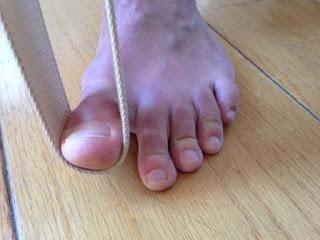 Q: Do you have any posts on yoga and hallux limitus, especially for those also with back issues (osteoporosis, DDD, osteoarthritis)? I use yoga as a main form of exercise and to aid in pain relief from these issues but am now faced with limited yoga poses as a result of limiting pressure on the big toes. Any advice would be welcome!
Q: Do you have any posts on yoga and hallux limitus, especially for those also with back issues (osteoporosis, DDD, osteoarthritis)? I use yoga as a main form of exercise and to aid in pain relief from these issues but am now faced with limited yoga poses as a result of limiting pressure on the big toes. Any advice would be welcome!A: In the past, I have written posts about conditions of the feet and toes that can lead to pain and dysfunction (see links below), but I have not specifically addressed the condition of the big toe known as hallux limitus. In the name of this condition “hallux” refers to your big toe and “limitus” (related to “limited”) means stiffness. In this case it is the joint between your long first metatarsal bone and the first phalanx bone of the big toe itself that is affected. As this condition develops over time, the stiffness and limited ability of the joint to extend (bend up away from the floor) can progress to pain, especially when walking and doing other weight bearing activities on the feet. The condition is often associated with people who have flat feet and an elevated first metatarsal bone, and also can develop after an acute trauma to the foot or recurring trauma, such as “turf toe,” which some athletes get after kicking the turf and jamming the big toe over and over again. The presence of stiffness may indicate some arthritic change to that toe joint, so if you suddenly develop persistent stiffness in your big toe it may be worth getting an X-ray.
Hallux limitus is sometimes also present in those with bunions, a condition known as hallux valgus, where the toe bones of the big toe shift toward the little toe side of the foot and swelling occurs in the inner edge of the joint. The bottom line is that as the big toe gets stiffer, and usually more arthritic (which an X-ray will indicate), it can affect your ability to walk pain-free with a normal gait, something you certainly would like to preserve if you can. There are four progressive stages to hallux limitus, and in the early stages, stretching the big toe is one of the recommended treatments (along with RICE—see Acute Orthopedic Injuries— and the use of orthotics). It is at this stage where I believe yoga can be of greatest help. Here are a few suggested options for you to consider:For an acute phase, where there is stiffness and pain (and maybe some swelling), I’d recommend doing non-weight bearing poses, especially where the feet can be up in the air, such as Reclined Leg Stretch pose, version 1 with the leg straight up.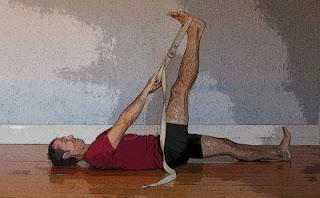 In these positions, try gently flexing and extending all the toes, with specific focus on the big toe, to maintain as much range of motion at the joint as possible. As pain improves, supported standing poses, such as Warrior 2 or Lunge poses with a chair, will to assess your ability safely bear weight if you can do them without pain.
In these positions, try gently flexing and extending all the toes, with specific focus on the big toe, to maintain as much range of motion at the joint as possible. As pain improves, supported standing poses, such as Warrior 2 or Lunge poses with a chair, will to assess your ability safely bear weight if you can do them without pain.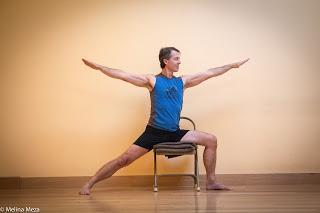
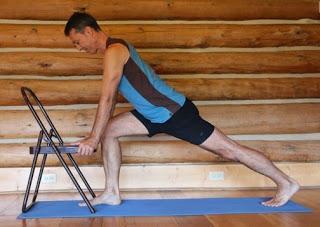
In non-acute phases, where stiffness alone or with only occasional brief pain is present, you can begin to work more actively in your standing poses. To strengthen the myofascial support along the inner arch towards the big toe, try doing the standing poses while lifting all the toes as far up off the ground as possible while the ball of the foot remains grounded. If you can’t lift your big toe on your own, try slipping a yoga wedge or a folded mat just under the big toe to encourage some extension. Start with short holds of 15-30 seconds and gradually work toward holds.
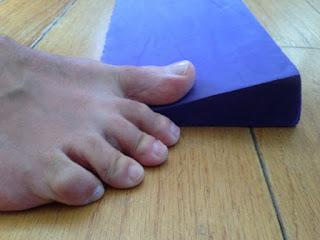 Another way to mobilize your big toes is to use a strap or elastic band under your big toes in a standing pose, such as Standing Forward Bend or Pyramid pose, where you have easy access to your big toe or toes. Once you are in the pose with the strap in place, slowly but actively lift up your big toe/toes into extension with the strap while keeping the ball of your foot/feet grounded. If osteoporosis and back pain are a concern, you can try this in a modified Standing Forward Bend, coming only part of the way down and not rounding your spine.
Another way to mobilize your big toes is to use a strap or elastic band under your big toes in a standing pose, such as Standing Forward Bend or Pyramid pose, where you have easy access to your big toe or toes. Once you are in the pose with the strap in place, slowly but actively lift up your big toe/toes into extension with the strap while keeping the ball of your foot/feet grounded. If osteoporosis and back pain are a concern, you can try this in a modified Standing Forward Bend, coming only part of the way down and not rounding your spine.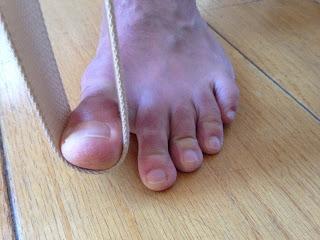 In poses where your back toes are turned under, such as Lunge pose, which requires more maximal big toe extension, you could try putting a wedge under the toes of your back foot to decrease the angle of bend a bit and gradually work your way back to have the toes on the floor.
In poses where your back toes are turned under, such as Lunge pose, which requires more maximal big toe extension, you could try putting a wedge under the toes of your back foot to decrease the angle of bend a bit and gradually work your way back to have the toes on the floor.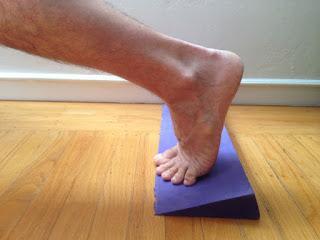 And definitely try out other creative ideas that you come up with on your own to help maintain as much pain-free mobility as you can. At this time there are no specific studies on the use of yoga for hallux limitus, but for all you yoga researchers and yoga therapists out there, this is new territory just waiting for you to look into it further!
And definitely try out other creative ideas that you come up with on your own to help maintain as much pain-free mobility as you can. At this time there are no specific studies on the use of yoga for hallux limitus, but for all you yoga researchers and yoga therapists out there, this is new territory just waiting for you to look into it further!Here are my previous posts on feet and big toes:
New Tricks for Old Dogs: Working with Bunions
Friday Q&A: Bunions, A Can, and A Rubberband
Your Feet on My Mind
(I will not be addressing the other back and bone conditions that the reader has mentioned, but we have also written about many of them on the blog, too.)
— Baxter
Subscribe to Yoga for Healthy Aging by Email ° Follow Yoga for Healthy Aging on Facebook ° Join this site with Google Friend Connect
